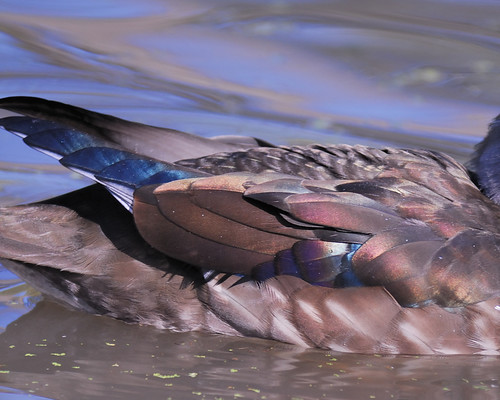tags: Female Wood Duck, Aix sponsa, birds, mystery bird, bird ID quiz
[Mystery birds] Female Wood Duck, Aix sponsa, photographed in Hermann Park, Texas. [I will identify this bird for you tomorrow]
Image: Joseph Kennedy, 16 November 2008 [larger view].
Nikon D200 Kowa 883 telescope with TSN-PZ camera eyepiece 1/320s f/1.0 iso400.
Please name at least one field mark that supports your identification.
Rick Wright, Managing Director of WINGS Birding Tours Worldwide, writes:
Hey, no fair! That's only part of a bird!
So go outside. Right now. And tell me how many whole birds you see. There are many measures of a birder's skill, but the one I like most is how small a part a birder finds identifiable. There's not much challenge in matching most whole birds to a picture in a book, but as our experience increases, we find ourselves needing less and less of the bird to reach a diagnosis.
So instead of moping about what we can't see in this quiz image, let's focus on what we can. This is a largish, fat-bodied, long-winged bird; its tail is visible only in part, but the very fact that it seems to have one rules out a number of groups we might find floating on the water, and pushes us in the direction of the waterfowl. The salient plumage characters are the extensive blue on the wing and the pattern of elongated white spots on the flank. I can think of nothing that exhibits those marks but a Wood Duck, and a quick peek at the right edge of the frame reveals the puffy crest characteristic of that species.
An earlier quiz discussion raised the unwelcome specter of Mandarin Duck, an exotic congener of Wood Duck that closely resembles the American species in its female plumages -- and is often seen in the wild. But even when we can't see the head and bill, as here, Mandarin can be ruled out by the gloss visible on some of the wing coverts (plain in Mandarin), the deep blue of the secondaries (dull green in Mandarin), and, especially, the shape of the white mark on each of the flank feathers: a broad shaft streak in Wood Duck, a rectangular blotch on Mandarin Duck.
- Log in to post comments


Is that a female wood duck?
It's... a Worm-Eating Warbler! :-)
No, seriously, this one is really tough for me. I'm sure there's someone out there who's going to point out some feather or other that is totally diagnostic, but that someone is not me.
I think it's a duck (though I spent some time wondering if it could be a gull). The little bit of bluish on the wing feathers on the left of the photo (which I think are primaries) is really giving me problems. It looks like the outer web is pale or white, and the inner web is an iridescent blue, which I can't match up with anything. There's also that one really blue feather peaking out under the scapulars; I don't know what's going on there.
I tried to talk myself into this being one of the "blue-winged ducks", specifically, Northern Shoveler, Cinnamon Teal, or Blue-winged Teal, but this bird doesn't look particularly like any of those birds as illustrated in Sibley.
I'm stumped.
Oh, darn. There it is in Sibley: "white primary edges unique".
Sigh. Another painful learning experience. :-)
Well, it's either a Wood Duck (Aix sponosa)or an escaped Mandarin (Aix galericulata). Without seeing the head, I don't know which. I'll be very interested in learning how to tell these two apart without seeing the head.
Ok, mght as well stick my neck out. I'll go with the wood duck ID, but think it's a non-breeding male rather than a female
Ok, mght as well stick my neck out. I'll go with the wood duck ID, but think it's a non-breeding male rather than a female
New at this I forgot to post my field marks. White edge along blue on primaries, small show of blue secondaries, speckled or mottled feathers on flank and tail appears long in relation to wing tips.
The light in this photo is tricksy. My first impression was Black Duck, but the white-edged blue primaries say no.
That's a Wood Duck.
It's a female Wood Duck. The primaries identify it as a Woodie (iridescent blue inner webs, white outer webs) and the color of the tertials, plus the iridescent purplish greater tertial coverts (of which only one or two are visible here) also identify it as a Wood Duck rather than a Mandarin female.
Your nose hair is pleasingly twisted with the roots of a bristlecone pine that is so precariously perched on the side of a cliff it may easily uproot and fall upon the Republican lobbyists below.